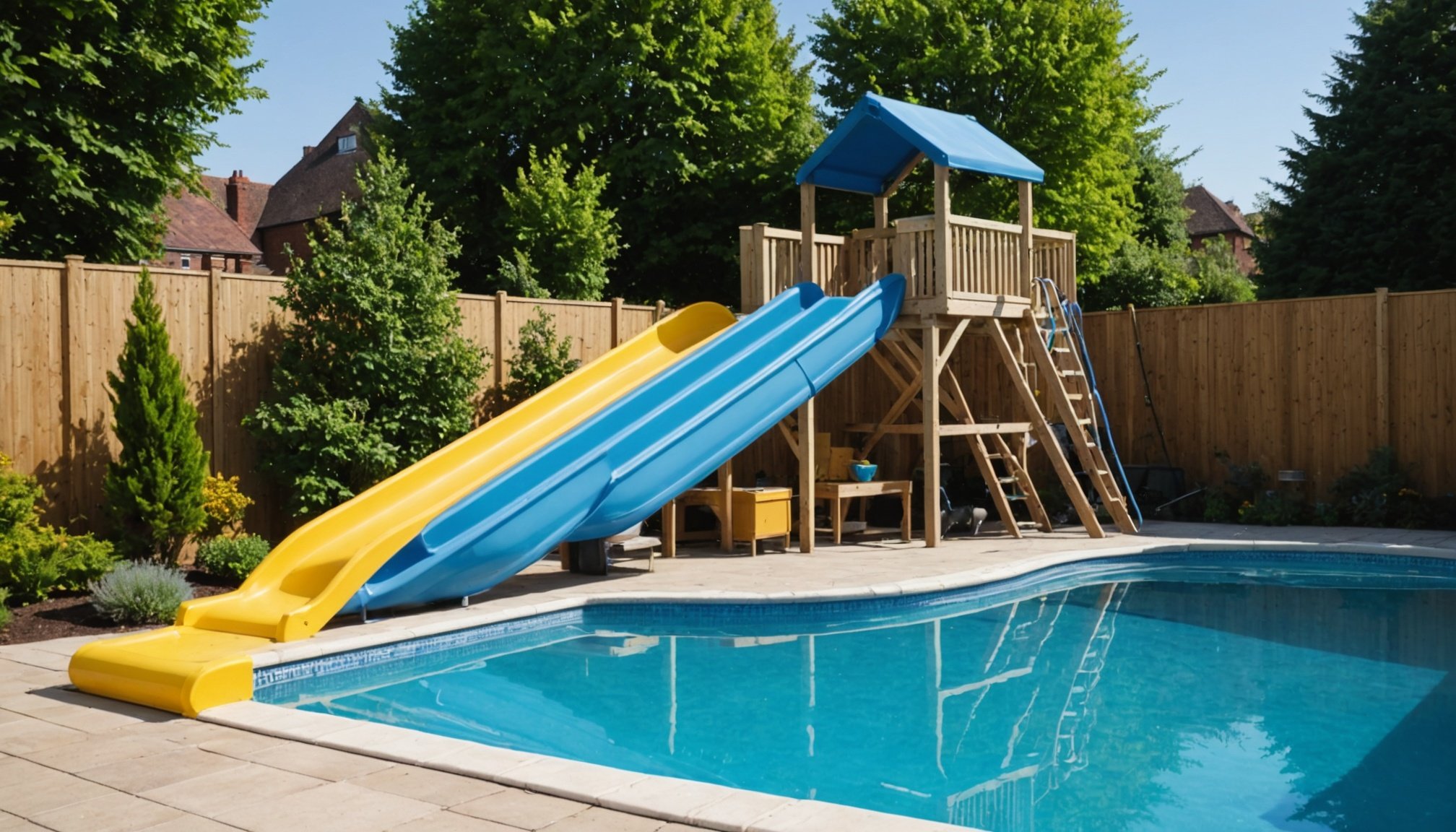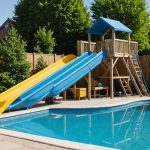Overview of UK Safety Standards for Pool Slides
Before diving into the fun, understanding UK pool slide safety standards is essential. These regulations ensure the safety and enjoyment of recreational installations, safeguarding users from accidents and hazards.
In the UK, safety standards for pool slides are governed by specific legislation. One major piece of legislation is the European Standard EN 1069, which lays out parameters for aspects such as material strength, design, and installation requirements. These standards aim to prevent injuries by ensuring that slides are constructed with safety in mind and that they adhere to stringent guidelines.
Also to read : Ultimate Guide to Ensuring Your Poolside Furniture Stands Up to the UK”s Unpredictable Weather
Various agencies hold the responsibility for overseeing compliance with these regulations. For recreational installations like pool slides, the Health and Safety Executive (HSE) plays a pivotal role. The HSE enforces safety measures and provides guidance to manufacturers and operators. Additionally, local authorities conduct inspections and ensure that standards are maintained at public pools.
By prioritising these standards, users can enjoy the thrill of pool slides without compromising on safety. It is crucial for designers, manufacturers, and operators to familiarise themselves with these requirements to maintain high standards of safety and security in recreational settings.
Also to see : Crafting an Organic Oasis: Designing a Pool That Harmonizes with the UK Countryside
Necessary Permits and Documentation
Installing a pool slide requires understanding and acquiring the necessary permits to ensure compliance with local regulations. These permits often include building permits and zoning permits, which vary based on the location.
Types of permits required typically depend on factors such as slide height and location. A building permit is generally mandatory for any structure attached to the pool. Zoning permits ensure that the pool slide adheres to local land use regulations. This is crucial to avoid potential fines or required removals later.
Proper documentation is essential for compliance. You will need architectural plans or drawings of the proposed slide and pool setup, along with any safety certificates. Additionally, some regions require engineer validation if the slide structure is more complex. Thus, collating these documents ahead of time can streamline the permit process.
Consulting with professionals in the industry is highly recommended. These experts can assist in navigating the permit acquisition process smoothly and ensure all required documentation is accurate and complete. Hiring a knowledgeable contractor can save time and ensure that all permits for pool slide installation are obtained correctly, allowing for a worry-free setup that meets all legal requirements.
Installation Procedures for Pool Slides
In the realm of pool slide installation, understanding the guidelines is crucial for a safe and enjoyable experience. Before diving into the installation, proper site preparation is paramount. Ensuring the area is clear of debris and obstructions not only provides a strong foundation but is essential for compliance with manufacturer instructions.
Site Preparation
A properly prepared site is the bedrock of a successful installation. Begin by selecting an area that is level and free from objects that could impair stability. This preparation minimises the risk of future complications, facilitating a seamless process.
Anchor and Support Requirements
Anchoring techniques are a fundamental component to the pool slide’s stability and safety. Manufacturers typically recommend using concrete or a similar sturdy material to anchor the slide securely. This helps in maintaining its position during use and inclement weather conditions. The correct anchoring ensures longevity and user safety.
Manufacturer Instructions
Adhering to manufacturer specifications is vital for correct installation. These guidelines are meticulously crafted to ensure that the slide functions optimally. Following the instructions to the letter prevents voiding warranties and maximises safety. Manufacturers provide detailed steps specific to each model, ensuring comprehensive understanding and execution.
Careful attention to these guidelines will lead to a durable and safe pool slide setup, ready for countless hours of enjoyment.
Essential Safety Features
When considering pool slide safety features, a comprehensive overview of what should be included is paramount for ensuring a secure and enjoyable experience. A primary safety feature to look for in pool slides is slip-resistant surfaces. These surfaces significantly reduce the risk of accidental falls and injuries by providing better traction, especially when wet. It’s equally important to ensure that pool slides are fitted with robust protective barriers. These act as crucial safeguards, preventing users from falling off the sides of the slide, particularly at elevated heights.
Regular inspection and certification of safety features are critical to maintaining their effectiveness. Pool equipment should be periodically checked by qualified professionals to ensure that all safety features are intact and comply with the industry’s standards. Certifications offer peace of mind, indicating that the pool slide has been evaluated and meets stringent safety criteria.
By integrating these essential safety features — slip-resistant surfaces, protective barriers, and regular inspections — pool slides can provide a safer environment for all users. Diligence in these areas encourages a fun and secure swimming season, minimizing potential hazards and boosting confidence in the equipment’s reliability.
Maintenance Requirements
Ensuring the safety and longevity of your pool slide necessitates regular maintenance practices. Proper adherence to these routine measures can significantly mitigate safety risks and enhance the functionality of the slide.
Routine Inspections
Conduct regular inspections at least once a month. Look for visible signs of wear and tear such as cracks, loose bolts, or unstable parts. Check the structural integrity of the slide and ensure that all fastenings are secure. This is essential for guaranteeing your pool slide meets safety standards and prevents accidents.
Repair and Upkeep
Prompt repair of any damages identified during inspections is crucial. Use recommended materials and tools specific to your slide type to fix any issues. Avoid makeshift repairs that could compromise safety. A well-maintained slide reduces the likelihood of accidents and extends its useful life.
Seasonal Considerations
Seasonal changes impose specific maintenance demands on pool slides. Before winter, drain and dry the slide to prevent water from freezing and causing cracks. In spring, thoroughly inspect and clean the slide before use. Implementing proactive, seasonal maintenance measures ensures a safe and enjoyable experience year-round.
Penalties for Non-Compliance
Ensuring adherence to safety standards for pool slides is not just advisable but legally imperative. Non-compliance brings notable legal repercussions that could severely impact property owners. For starters, failing to comply with pool slide safety guidelines can result in substantial fines. These penalties are designed to encourage property owners to prioritise safety, ensuring that slides meet all regulatory standards.
Beyond fines, non-compliance can lead to significant liabilities. Should an accident occur due to non-compliance, the property owner may face costly legal battles. The financial implications can be substantial, encompassing medical costs, legal fees, and potential compensation claims. Owners may also face heightened insurance premiums or even policy cancellation.
The threat of fines and liabilities underscores the critical importance of maintaining compliance with safety regulations. Following standards doesn’t just safeguard finances; more importantly, it prevents serious safety hazards. Accidents can lead to injury or even loss of life, casting a shadow on the joys of owning a pool. By adhering to regulations, owners can protect both their assets and the well-being of all pool goers, creating a safe and enjoyable environment.
Resources and Additional Links
Choosing a pool slide is exciting, but ensuring compliance with relevant regulations is crucial for safety and functionality. Below are resources to help navigate this process effectively.
Relevant Regulations
For those seeking compliance resources for pool slides, understanding the regulations is key. In the UK, one must adhere to standards such as the British Standard (BS EN 1176) for playground equipment, which can apply to residential pool slides too. These guidelines highlight the importance of factors like slide slope, barrier height, and landing area safety. Access to authoritative regulation documents can assure that your pool slide meets these essential criteria.
Professional Consultation Services
Engaging professional consultation can be invaluable. By leveraging the expertise of specialists familiar with compliance resources, you gain insights into achieving a compliant installation. Professionals evaluate your site, identify potential issues, and provide actionable solutions. They ensure all elements meet safety and technical standards, preventing costly adjustments post-installation.
Case Studies of Compliant Installations
Learning from case studies of compliant installations is beneficial. Successful installations demonstrate practical applications of compliance guidelines, illustrating what works well. For instance, specific projects can show how to combine aesthetic design with strict adherence to UK standards. These examples serve as a learning tool, proving that compliance and creative designs can coexist, delivering both safety and enjoyment.











